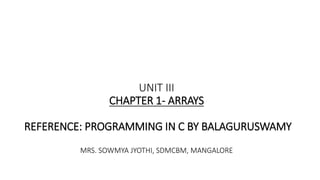
Arrays in c unit iii chapter 1 mrs.sowmya jyothi
- 1. UNIT III CHAPTER 1- ARRAYS REFERENCE: PROGRAMMING IN C BY BALAGURUSWAMY MRS. SOWMYA JYOTHI, SDMCBM, MANGALORE
- 2. Array : Array is a derived data type. • When it is necessary to store more than one value under a variable, user can make use of array. •An array is a fixed-size sequence collection of elements of the same data type. •It is simply a grouping of like-data type.
- 3. Different types of arrays : There are three types of arrays. They are, 1. One dimensional array. 2. Two dimensional array. 3. Multidimensional array.
- 4. One dimensional array : •A list of items can be given one variable name using only one subscript and such a variable is called a one dimensional array. Example : int number[5]; • Here in the example, 5 value of the variable number can be kept under the single variable number.
- 5. Declaration of one dimensional array : Like any other variable, arrays must be declared before they are used. •The general form of array declaration is, • type variable_name[size]; The type specifies the type of elements that will be contained in the array, such as int, float etc. The size indicates the maximum number of element that can be stored inside the array. For example, float height[50]; This declares the height to be an array containing 50 real numbers.
- 6. Two dimensional array : •When by using an array, user can store two value, each for a row and a column under a variable, the array is then called a two dimensional array. Here, user can use infinite number of rows and columns. Two dimensional arrays are declared as follows, • type array_name[row size][column size]; •Eg: int a[3][4];
- 7. Multidimensional array : •C allows arrays of three or more dimensions. The exact limit is determined by the compiler. •The general form of a multidimensional array is, • type arrayname[s1][s2]......[sn]; Where sn is the size of the dimension. For example, • int survey[3][5][12] survey is a three dimensional array declared to contain 180 integer type elements.
- 8. Initialization of one dimensional array : After an array is declared, its elements must be initialized. An array can be initialized either of the following stages, 1. At compile time. 2. At run time.
- 9. Compile time initialization : User can initialize the elements of an array in the same way as the ordinary variables when they are declared. This is compile time initialization. The general form is as follows, • type arrayname[size]={list of values}; The values in the list are separated by commas. For example, • int number[3]={0,0,0}; This will declare the variable number as an array of size 3 and will assign 0 to each element.
- 10. Run time initialization : • An array can be explicitly initialized at run time. This approach is usually applied for initializing large arrays. For example, for(i=0;i<100;i=i+1) { if (i<50) sum[i]=0.0; else sum[i]=1.0; } The first 50 elements of the array sum are initialized to zero while the remaining 50 elements are initialized to 1.0 at run time.
- 11. Initialization of two dimensional array : Like the one dimensional arrays, two dimensional arrays may be initialized by following their declaration with a list of initial values enclosed in braces. For example, int table[2][3]={0,0,0,1,1,1}; This initializes the elements of the first row to 0 and the second row to 1. This statement can also be written as, • int table[2][3]={{0,0,0}, {1,1,1}}; • This can also be written as, int table[2][3]= { {0,0,0}, {1,1,1} };
- 12. marks [0][0] 35.5 Marks [0][1] 40.5 Marks [0][2] 45.5 marks [1][0] 50.5 Marks [1][1] 55.5 Marks [1][2] 60.5 marks [2][0] Marks [2][1] Marks [2][2] marks [3][0] Marks [3][1] Marks [3][2] Elements of multi dimension arrays: A 2 dimensional array marks [4][3] is shown below figure. The first element is given by marks [0][0] contains 35.5 & second element is marks [0][1] and contains 40.5 and so on.
- 13. min=a[1] i.e min=36 i=2 a[2]< min 55<36 NO i=3 A[3]< min 23<36 YES min=23 SWAP i=4 A[4]<min 12<23 YES min=12 SWAP i=5 A[5]<min 95<12 NO 1 2 3 4 5
- 14. max=a[1] i.e max=36 i=2 a[2]> max 55>36 YES max=a[2] max=55 SWAP i=3 A[3]>max 23>55 NO max=55 No change in max i=4 A[4]>max 12>55 NO i=5 A[5]>max 95>55 YES Max=a[5] max=95 SWAP i=6 A[6]>max 44>55 NO
- 15. • The Fibonacci Sequence is the series of numbers: • 0, 1, 1, 2, 3, 5, 8, 13, 21, 34, ... ... • Fibonacci Series is a pattern of numbers where each number is the result of addition of the previous two consecutive numbers . • First 2 numbers start with 0 and 1. • The third numbers in the sequence is 0+1=1. The 4th number is the addition of 2nd and 3rd number i.e. 1+1=2 and so on. The next number is found by adding up the two numbers before it: • the 2 is found by adding the two numbers before it (1+1), • the 3 is found by adding the two numbers before it (1+2), • the 5 is (2+3), • and so on!
- 16. f1 f2 f3 f1 f2 f3 { f3 = f1 + f2; printf(" %d", f3); f1 = f2; f2 = f3; }
- 18. How to reverse a number mathematically. • Step 1 — Isolate the last digit(rem) in number. rem = number % 10 The modulo operator (%) returns the remainder of a divison. • Step 2 — Append lastDigit(rem) to reverse. reverse = (reverse * 10) + rem • Step 3-Remove last digit from number. number = number / 10.